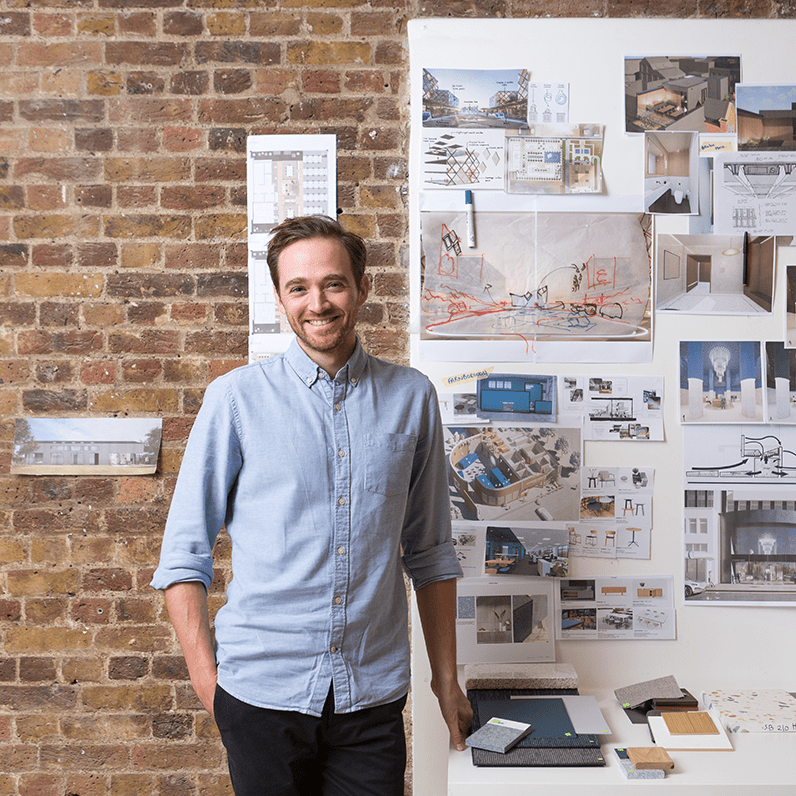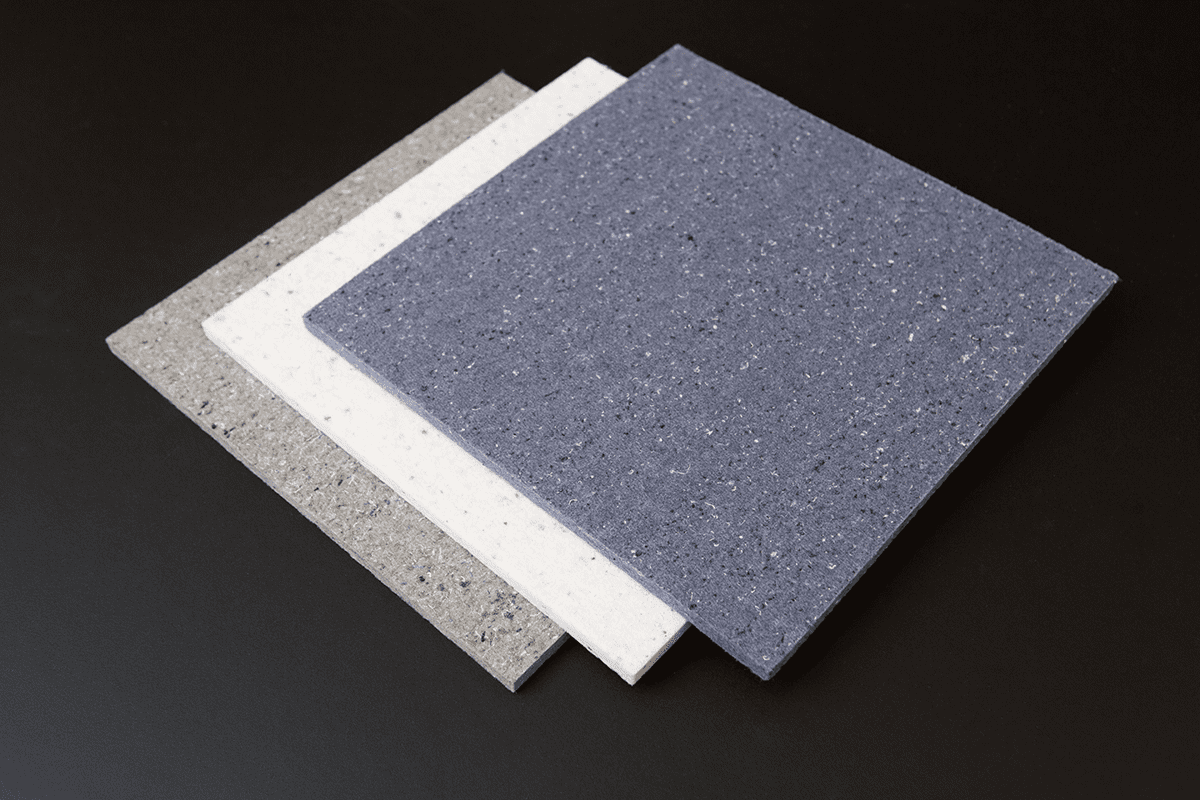Director Joe Haire explains how the practice’s growing interest in sustainability and the circular economy is reshaping its approach to design and materiality.
Joe Haire pictured in front of current projects with corresponding material samples.
Based in London’s Shoreditch, but with a satellite office in Mumbai, White Red Architects is an ambitious young practice with a staff of 15 founded in 2017 by directors Joe Haire, Dicky Lewis and Jesus Jimenez. The London office recently moved across the street to a former shop premises where it can better engage with its busy urban context. Despite its tender age, the practice has carved out a niche for itself designing high-quality office refurbishments that unusually balance creativity with environmental responsibility and occupant wellbeing.
White Red’s growing interest and expertise in circular design and modular construction now permeates all aspects of the business – not least the materials library where fundamental questions relating to sustainability, reuse and recycling are considered alongside more traditional concerns over aesthetics, fitness-for purpose, and cost. Located towards the rear of the studio, the materials resource may be modest in size, but its scope goes far beyond the physical objects
Resin flooring from Sphere8. “We like this product because it can be laid very thin, and is therefore perfect for retrofit projects. It provides a beautiful seamless finish and is available in virtually any colour. We recently used it on the Henrietta Street office refurbishment project in Covent Garden, where it was colour matched (racing green) to wall, ceiling and soft furnishing elements.”
How is the library organised?
The library is evolving, and what we are trying to do is change the emphasis away from a collection of materials we have used in the past – although we do keep some as artefacts of important projects – to a resource containing only items that relate to the circular economy. We’ve taken the view that everything should become circular, including entire buildings. It’s an intimidating challenge as not every part of a refurbished or retrofitted project can go back into the supply chain at present. However, the logic is that a building will be refurbished three or four times until it eventually becomes a circular entity.
This goes hand in hand with creating a high-performance digital model of the building, containing smart information on every component, and how each element can be repaired, reused or recycled in the future. On an office refurbishment, for example, the model might contain contract details with the carpet manufacturer, enabling the existing carpet to be collected and recycled rather than thrown away.
Terrazzo from Inopera. “We are using this product at Bruton Place, a high-end office fit-out in Mayfair, London. Not the most environmentally friendly material, but it will be used among sustainable products, including acoustic tiles made from recycled textiles.”
How easy is it to find materials that fit the bill?
It’s not easy at all, but we do already have a number of materials that are circular, ie they are completely derived from recycled products or can be entirely reused in different ways or can be broken down into their raw components for reuse. We tend to ask suppliers we are working with if they have other products that fulfil specific criteria, even if we don’t use them at that specific time. This enables us to build up a knowledge base of what is available, ready for deployment in the future. It’s a slow process but it’s important to keep making small steps and record what you find. It’s also about discovering people within companies and organisations that share the same belief and connecting with them.
Marmoleum from Forbo Flooring Systems. “Made from natural raw materials, including flax and jute, Marmoleum flooring is CO2-neutral (cradle to gate).”
So, the materials library is made up of both physical samples and a data log of what is available from certain suppliers?
Yes, this is key to what we are trying to do. The practice takes a database approach to both design and practice management. We find that if you fail to record connections in a meaningful way you can draw on later, then that work has been wasted. By using databases for projects, clients, suppliers and materials, you discover different connections and relationships betweethem, which in turn can help drive the circular construction model.
We have already built a system for our CRM (client relationship management). Within the materials database, we record a range of attributes, including how specific products contribute to wellness, urban biodiversity and of course circular design. Above all, the information in each database must be relevant and accessible – it can’t just be a collection of Excel spreadsheets.
Embodied Beauty carpet tiles from Interface. “The carpet tiles are carbon negative (cradle to gate), meaning that they sequester and offset more carbon than they generate. At the end of their life, they can be collected by the manufacturer for reuse or recycling via its ReEntry initiative. Both materials are high quality and hardwearing.”
Are product samples still important?
They’re fundamental. You need to be able to touch and see materials to understand them and get a feel of the overall quality. You also need to be certain that you are getting something you genuinely believe in.
We often find that circular materials are not necessarily the prettiest products available due to their recycled content. By holding such a product in your hand, you can think of ways of “reframing” it in a design sense – for example, by lighting it in a way that draws attention to its texture, or purposely contrasting it with more visually refined materials. On design projects, we investigate and develop this process using real-time rendering software on VR models. This approach can help to make circular product choices more enticing for our clients.
Silicastone from Alucid. “This is one of a collection of highly sustainable materials we are using on the Alexander Dennis headquarters building in Farnborough. It’s made from 98% recycled materials, such as glass and ceramic products,and is manufactured in the UK. There are a range of finishes to choose from, including glazed and terrazzo effects. The material is highly durable so it will be used on stepped seating areas and for super-sized skirting elements”.
At what point in the design process do materials become a focus?
From the very beginning. We have a palette of materials we like or would like to draw on and, while it’s a little bit like putting the cart before the horse, it does establish a modus operandi in terms of circular design. It also provides an additional talking point or headline for the client if a material we choose not only fulfils the design brief but also demonstrates how a particular waste stream has been repurposed. Of course, when you are using new materials, you do have to think very carefully about fixing methods and fire treatment solutions that satisfy the Building Regulations without compromising environmental performance.
Cube from Autex Acoustics. “This versatile semi-rigid acoustic panel is a felt largely made from recycled plastic. It’s easy to cut and can be used in a range of different ways.”
Are your clients responsive to this approach?
Commercial clients in particular are becoming much more aware of the importance of sustainability and the circular economy. Our approach is journey led. It’s about saying to the client: this is the space you need, this is how it’s fulfilling the design brief and, by the way, this material would be the best choice for these reasons. We find this is often the best way of introducing innovative new materials.
What materials have you discovered recently that interest you?
Carbon sequestering materials, such as hempcrete, are something we are very interested in. We particularly like the idea of locking up carbon indefinitely within circular building projects. Hempcrete in its raw form looks horrid! But it’s an emerging technology and can be used to make structural blocks among other things. It also has excellent thermal and fire properties.
What is perhaps most interesting about a material like hemp is that it could theoretically be 3D printed, providing both enormous design flexibility and endless recyclability on retrofit projects. This kind of technology, combined with advanced BIM models and “smart”buildings, will ultimately enable clients and building users to adapt and reshape their environments at will. Architects could, therefore, be liberated from some of the more mundane aspects of their work, giving them time to focus on design elements that bring delight.
Hempcrete from Hempcrete UK. “Carbon-sequestering and adaptable, this innovative material can be used as a
sustainable alternative to concrete blocks. It also has excellent fire and thermal performance properties.”
Do you find yourself returning to certain materials, and if so which ones and why?
We do. A good example is Autex Cube, which is a largely – not fully – recycled plastic felt. It’s easy to cut and can be used in a range of different ways, including as an acoustic lining. Another one is Sphere8, a high-performance floor resin, which can be very shallow (around 3-5mm) so it can be poured over the top of existing finishes, eschewing the need for on-site removal and disposal. It also means you don’t have to change lift and door thresholds on refurbishment projects. Added to this, the resin can be RAL-coloured and/or accept aggregates, transforming it into a very high-specification material if required.
Really Acoustic Textile Felt FR from Kvadrat. “This innovative material comprises 70% recycled textiles and can be used on both internal walls and ceilings. It also has flame-retardant properties. One of the products in the range incorporates recycled denim, which sounds faddish, but can actually help clients buy into the idea of upcycled materials.”
Is there a material you would like to use, but haven’t been able to yet?
Yes, it’s hempcrete. We’ve tried to use it as structural walling on two projects, but found the cost prohibitive. It would be more cost effective to use it as a facing material, providing you could celebrate its roughtextured appearance and environmental credentials. Return on investment is the interesting idea here. Hempcrete blocks may cost much more than traditional cementitious ones, but if they form part of a building’s “bank” of circular components, they could prove much more cost-effective in the long run. It’s a case of getting better at the pitch, so clients will go the extra mile in terms of sustainability.
Acoustic Pulp panel from Baux. “This acoustic tile is made from wheat bran, potato starch and other natural, carbon-sequestering materials.”
What happens to material samples at the end of the project? How do you reduce waste?
To be honest, I think there has been quite a lot of waste. Our practice is fairly new and has grown rapidly, so we’ve needed to get samples quickly, and suppliers have tended to send way too much. In retrospect, we should have had conversations with them before we requested the items. And although we’ve tried to recycle as much as possible, a lot has been thrown away.
What we are doing now is asking the question: if you send us a sample, will you take it back? Unfortunately, most of the time manufacturers say no. We also only order samples if we really need them.
What we’ve done recently on a high-end office refurbishment in Mayfair is to treat the experimental coffered ceiling site mock-up as both a design vehicle and benchmarking exercise, so it gets incorporated into the build once it’s been approved, and sets the standard for the rest of the installation. Perhaps most importantly of all, the mock-up is not thrown away once it has served its developmental purpose.
























